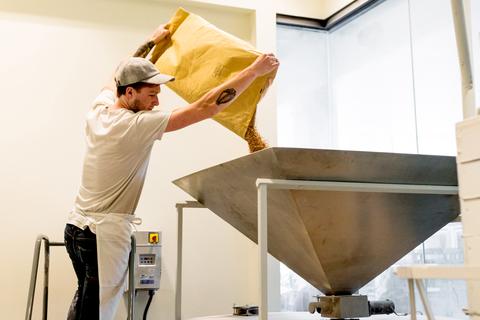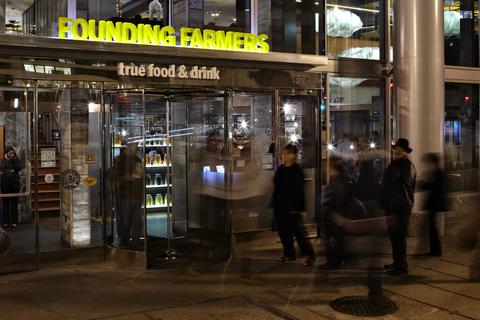Posted by Brian Shilhavy on Apr 25, 2020

Previously I reported about the shortages of meats at supermarkets, and how this reflected not a shortage of meat in the U.S., but the failures of our supply chains when a nationwide crisis hits, such as the Coronavirus scare has done.
I discussed how allowing local communities to directly access meat from farmers and ranchers in their own counties and states was the solution to food security issues in our nation’s meat supplies.
See:
Is Wyoming’s Food Freedom Act with Farm to Consumer Direct Sales a Model for Food Security for the Rest of the U.S.?
The publication Civil Eats has done an excellent job of reporting on these kinds of problems that are systemic within our nation’s food supply chains.
In another excellent investigative report on flour shortages that many are starting to see around the country, Amy Halloran has written an excellent article titled:
Flour Shortage? Amber Waves of Regional Grains to the Rescue: A grain and flour expert enthusiast says the local flour revolution is tastier, healthier, and has created more robust markets.
Again, as we saw with the meat market, there is currently no shortage of flour in our nation. The issue is the frail supply chain.
Some excerpts from Halloran’s excellent article:
There is no flour shortage in America.
Outside the taut supply chains of industrialized food, small flour mills are working double-time to fill fresh flour orders for dedicated fans and a new crowd of bakers. And while these local millers have been around for generations, it took a pandemic to reveal them as alternatives to the dominant grain system. Today, having a relationship with nearby grain farmers seems like a more secure route to bread than it was just a month ago.
Industrial milling and factory baking set the standards for what gets grown, and the global marketplace sets the price. Farmers are servants to massive debts they’ve had to take on to purchase equipment, and each year they borrow more money just to pay for inputs, labor, and other expenses.
Outside of this industrial baking complex, there exists a world of farmer-cultivated grain systems that not only address the limited choices farmers face inside the conventional system, but also produce delicious, fresh flour, which is generally stoneground and full of the fat and flavor that industrial processing strips away. And it is as different from its supermarket cousin as a tree-ripened peach is from a can of cling peaches.
People who are just awakening to the promise of regional grains will be surprised to see just how many exist, how well-rooted they are—and how they’re ready to supply you with grains that will change your life.
There are many community grains, produced, processed, and distributed within local and regional value chains that remain intact despite the pandemic.
By adapting food systems to a regional scale, farmer-leaders…. are taking risks to better support and care for the land they steward from the ground to the bank. They’re giving consumers an opportunity to buy staple crops that invest in soil health, water quality, and carbon sequestration while offering skilled jobs that employ local folks—on the farm, at the mill, and in craft bakeries.
When Restaurants Become Grocery Stores
In yet another excellent article published by Civil Eats, Jodi Helmer wrote a report titled:
Restaurants Are Transforming into Grocery Stores to Survive the Pandemic: Selling sought-after eggs, flour, and toilet paper directly to consumers has provided an ‘emergency transfusion’ for restaurants
In our article about Wyoming’s Food Freedom Act and the nation’s meat supply issues, we mentioned how the closing of restaurants and other venues that serve food, such as sporting and entertainment events, was what was putting a strain on the meat market supplies.
With the entire nation confined to their homes and unable to visit restaurants and other venues where food is served, this in turn created a huge demand for more food at grocery stores, while bulk food distributors were left with an excess of inventory that was not packaged properly for retail sales.
Helmer’s article documents how some restaurants have dealt with this situation while solving two problems at once: providing more business for their restaurant so they could stay in business, and providing much needed items to their consumers that they could not find in their local grocery stores, such as eggs, flour, and toilet paper.
Some excerpts from Helmer’s excellent article:
A few short weeks ago, Sarah Heard was cooking dishes like charred duroc pork, veal sweetbreads, and butternut risotto and serving them in the Austin, Texas, restaurant Foreign & Domestic.
Now, the dining room is closed, and instead of serving nose-to-tail suppers, chef/owner Heard is filling bags with groceries. In the last two weeks, she has stocked (and sold out of) staples such as eggs, salt, and lemons; customers purchased 100 pounds of flour in a single afternoon. The coronavirus pandemic has led Foreign & Domestic to evolve from a full-service restaurant into a grocery store.
“We knew that people were having trouble finding things at the stores,” Heard recalls. “We thought it could help the neighborhood—and it’s possibly the only reason we’re staying afloat.”
The pandemic dealt a significant blow to restaurants. The latest data from the U.S. Department of Labor shows that the U.S. lost a total of 701,000 jobs in March; restaurants and bars accounted for 60 percent of those losses.
The devastation had forced restaurants to get creative to keep their doors open. In addition to offering takeout and deliveries, steakhouses are being reinvented as butcher shops, upscale eateries are hosting virtual cocktail classes, and chefs are creating DIY meal kits.
Turning dining rooms into supermarkets is also proving popular.
How Do We Change the Nation’s Food Supply Chains?
Food security is a serious issue in this country, and the Coronavirus scare should be a wake-up call for everyone. As far as the food shortages in our grocery stores, this might get worse before it gets better.
And remember, this is all simply the result of people staying home. Imagine how much worse this could be if there were disruptions to our energy sector, and our truckers who transport all this food all across the nation could not get diesel fuel to power their trucks?
Or a disruption to our electrical grid where all of stored refrigerated and frozen foods would quickly spoil? Or even worse scenarios where communication systems went down, such as cell phones and the Internet, and without the ability to communicate to the public things would quickly spin out of control into rioting and looting.
What is the answer to the food security issue?
Those who have followed our reporting on this issue for the past decade or so will know that my position is that government is NOT the solution, but the problem.
Government food policies are what have created the fragile system we have created, with their cheap subsidized commodity food systems along with their fragile supply chains that are so easily disrupted.
No, the answer to food security lies in YOU, the American consumer. Small businesses all across the country, like many of those featured in the articles reported by Civil Eats, are happy to step in and fill in the gaps. They don’t need, and I am sure most do not want, government subsidies to fuel their businesses.
They need you, the American consumer, to start changing their buying habits, and start supporting local businesses.
We need a return to the “old fashion” way of conducting business, where there is a town butcher, a town baker, local grain mills, and local dairy farms and other kinds of farms producing and selling meats, produce, dairy, and other food staples to the consumer directly through local businesses.
Those in the metropolitan areas need to find like-minded neighbors and fellow city residents to band together and form co-ops and buying clubs to support farmers that may be located further out in the rural areas, to more efficiently bring that food from the farm to the tables of those in the cities.
When this country was founded in the 1700s, 90% of the population was involved in agriculture. When the Civil War started under President Lincoln, it was about 50% of the population in agriculture feeding the other 50%.
Today it is less than 1% of the population feeding the other 99%, and just a handful of companies controlling the nation’s food supply.
There is only one way we are going to see more food security in our nation, and it begins with the American consumer, and the consumer’s willingness to sacrifice “convenience” to have one-stop shopping centers that offer everything at cheaper prices (and almost always also cheaper quality food) due to government subsidies.
Will it happen? Will this be enough of a wake-up call to get even 10 percent of the nation’s population to change their buying habits? Because that is probably all it will take to turn the tide and start things rolling in the right direction.
But if everyone sits around and waits for the government to provide solutions, we can see what their history is. They will decide who to bail out and who not to bail out, and they will decide who wins and who loses. And we all know how that turns out.
If government truly wants to help bring food security to our nation’s food supply chains, then the best thing they can do is REMOVE barriers that prevent direct farm-to-consumer sales, such as the Wyoming Food Freedom Act that I highlighted earlier this month, and then get out of the way and let consumers and small businesses flourish in this nation once again.
As long as we still have a vestige of a free society left, the American consumer is still the most powerful force to change our food security problem in the U.S.


